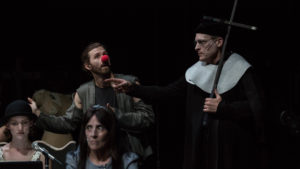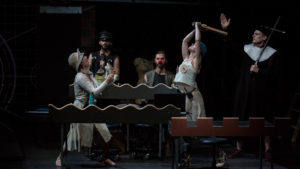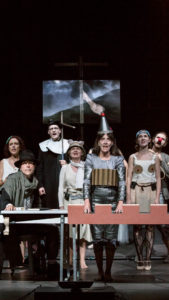
It is easy to understand the appeal of New York-based theatre company The Wooster Group. They have done challenging, fascinating and thought-provoking work for over 40 years. So when their new project A Pink Chair (In Place of a Fake Antique) opens tonight at the REDCAT Theatre downtown, there might be an unfamiliar name amongst the program notes. That is the name of Polish writer, stage director and artist Tadeusz Kantor. The play, which was commissioned by the Adam Mickiewicz Institute, was to be about Kantor. So if you don’t know who he was you might be asking yourself, “Should I?” Thankfully actress Kate Valk, who is a longtime member of The Wooster Group and part of these performances, can provide some insight.
I spoke with her on the phone a few hours before tonight’s opening performance.

For neophytes who aren’t familiar with Tadeusz Kantor and his work, what makes him a compelling figure in the history of theatre and the arts?
He really speaks to what it is about theatre that makes it something essential to the human spirit. And it’s sad. It’s poor, in the most spiritual sense of the word “poor.” I would say also most important is he was a visual artist, so he’s speaking in images as well and something that I think isn’t so American. He’s dragging the pitiful humanness and wretchedness that is theatre…the lowest of the low. It’s a commentary on human nature and it’s visually stimulating. He’s speaking to you in dream images as well. He was in reaction to the bourgeoisie.

Given his interests as you just defined them, how would Kantor respond to what’s going on in the world today?
I think he’d keep making work as long as he could with his sense of irony, bitter happiness. What else can the artist do except go to the bottom and accept the bottom and find the place to go on from which is what we’re facing now with such derisive times.
Where do we all commune? What is essential to all human spirit? I love the line he says, “I knew I had to make one more sacrifice.” I think of that every time something happens in rehearsal. That’s the ritual. The sacrifice. It’s freedom of expression and what is the artist’s responsibility.

Yet we’re living in a time where people in power think it is a good thing to suppress such expression.
It’s relentless. Again. Here we are. Here we are once again. You know what I mean. This is a refrain. Can we learn from the past? These are the questions of the piece as well. Art is a place where we encounter these big themes we can meditate on and that’s the function of art.
How would you describe A Pink Chair?
A Pink Chair is us meeting him. And it’s about us, The Wooster Group, we’re a theatre group, too. It’s like a picture coming into resolution. It’s us meeting him and making a place. There’s a lot of emptiness and making space for maybe the spirit of Kantor to inhabit the room.
A Pink Chair was originally performed at Bard in 2017. Has it evolved since then?
That was really, for us, the first showings and Liz [LeCompte – Director and Founding Member of The Wooster Group] operates much more like a visual artist in the studio. We go back and with everything we learned and she learned from performing it in the first round. We further refined the structure and the technical execution of the piece. I imagine through these two weeks at REDCAT it will be fine-tuning the piece so there will maybe be some small changes and tweaks and nips and cuts and sharpening – looking for the dynamic the whole time we are here.
Kantor’s I Shall Never Return, has been like the North Star for this production. Why?
We are a theatre company who has been working together for 40 years. I’ve worked with Liz for 40 years and I wasn’t even a first member of The Wooster Group. I came in on her fourth piece. She had made the trilogy with Spalding Gray. We’ve been around a while and we’ve been down many roads together.
I think this is a parallel point in Kantor and LeCompte. We could have chosen anything from his writing or manifestos or theatre productions. But I Shall Never Return spoke to us because of our age.
In a moment I will enter with my “luggage”
a shabby and suspicious
i n n.
I have traveled to it for a long time.
At nights.
Sleepless nights.
I have traveled here to meet,
I am not sure what, with apparitions or people.
To say I’ve been c r e a t i n g them
for many, many years
would be an overstatement.
I gave them life, but they also gave me theirs.
They were not easy to deal with; nor were they obedient.
They have traveled with me a long time
and gradually left me at various roads and stops.
Now, we are to meet here.
Maybe for the last time.

Mullin and Gareth Hobbs in “A Pink Chair”
Hilton Als in the New Yorker called you one of the greatest theatrical figures the American stage has produced the last forty years or so. The head of programming for the Public Theatre referred to you as “The Meryl Streep of downtown.” How do comments like that land with you?
I’m very fortunate that I have a home, an artistic home, every day and people I work with. So I’m not invested in reading and collecting press. I try not to take it too seriously. Anytime something like that is said I really appreciate it. But I stay pretty focused. There’s always problems and things to surmount and solve in The Wooster Group. So I’m very lucky that I have a place that provides the balance.
A Pink Chair (In Place of a Fake Antique) runs through April 15th at REDCAT.
Photo of Kate Valk courtesy of The Pew Center for Arts & Heritage
Production Photos Credit: Maria Baranova











